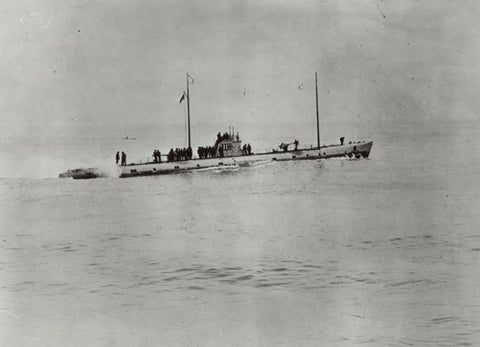
U-111, a WWI Submarine That Was Thought Lost Forever, Has Been Found
After 100 years, one of the last World War I-era German U-boat submarines destroyed off the U.S. coastline has been found, according to National Geographic.
It was a discovery that was never meant to be.
Sunk by the U.S. Navy in 1922 — four years after the end of the war — U-111 was thought to have found its final resting place on a seabed 1,600 feet down, 40 miles off the coast of Virginia.
There it lay, submerged in the salty Atlantic waters for more than a century, until maritime historian, shipwreck researcher and technical wreck diver Erik Petkovic discovered it on Sept. 5, a mere 400 feet below the surface.
The underwater drone moved closer and closer.
Was that the wreckage of a German U-boat?
Was that WWI's infamous and once-fearsome U-111 sitting off the coast of Virginia?
Yes. And yes.https://t.co/JDXFs7361I @NatGeo @kristinromey @heatherjkim @jentse-- David Beard (@dabeard) September 30, 2022
Who Found U-111?
Petkovic, according to the National Geographic, first became interesting in diving after he was inspired by Robert Ballard’s discovery of the wreck of the Titanic in 1985. He began exploring the shipwrecks of the Great Lakes before making his way east for oceanic excursions.
Five other German submarines from WWI had been found in U.S. waters since 1922, but the location of U-111 had remained elusive until now.
History of U-111
Launched on Sep. 5, 1917, the U-111 made three somewhat lackluster patrols before surrendering to the Allies after hostilities ended on Nov. 11, 1918. After the sub made way to Harwich, England, the U.S. Navy asked for several of the latest German U-boats. Their intentions were not only to study their technology, but to parade the defeated submarines during a Victory Bond campaign in the United States.
The British, according to Naval History and Heritage Command, “allocated six boats (U-117, U-140, UB-148, UB-88, UC-97 and U-164) to the United States on condition that they be destroyed within a year of the transfer.”
After a crash course on the mechanics of the foreign sub, a U.S. crew powered the craft through harrowing “fog, gales, and heavy seas” that harassed the U-boat all the way across the ocean, the Naval History and Heritage Command wrote.
Perhaps even more harrowing? As the food supply became perilously low, the crew had to resort to eating jam and pickles for the final three days of the journey.
U-111 in NYC
In spite of the pickle and jam predicament U-111 successfully moored in New York City on April 17, 1919, with plenty of time to carry out her tasks in the Victory Bond campaign.
There, swarms of tourists, reporters and photographers freely roamed the ship that a year earlier had been patrolling the waters of the Atlantic against them.
“Navy technicians and civilian shipbuilders also came to try to learn everything they could about German submarine construction in the brief time before U-111 __ departed New York,” according to the Naval History and Heritage Command.
After evaluating the U-111 against an American-made sub, the S-3 (submarine No. 107), experts reported the U-111 was “congested, overly complicated, and difficult to maintain,” while the S-3 was “habitable, accessible” and “more seaworthy.”
U-111’s Final Mission
Despite being decommissioned in 1921 after the victory bonds tour, the U-111 resisted Allied attacks to the last.
Though it was slated to be used for target bombing tests by the U.S. Army and Navy, U-111 began taking on water as it was towed toward the practice site.
“Some 50 miles short of her destination, she sank by the bow in 35 feet of water on 18 June 1921 approximately three miles off Cape Henry. … [T]he minesweeper Falcon … towed her to the Norfolk Navy Yard, Portsmouth, Va., where, soon after being placed in Dry Dock No. 3, she sank again before she could be pumped out,” according to Naval History and Heritage Command.
The following day the U.S. Navy removed the water, sailed it out to sea then sank the sub at long last, where it remained undisturbed for more than a century.
Until Petkovic, that is.
